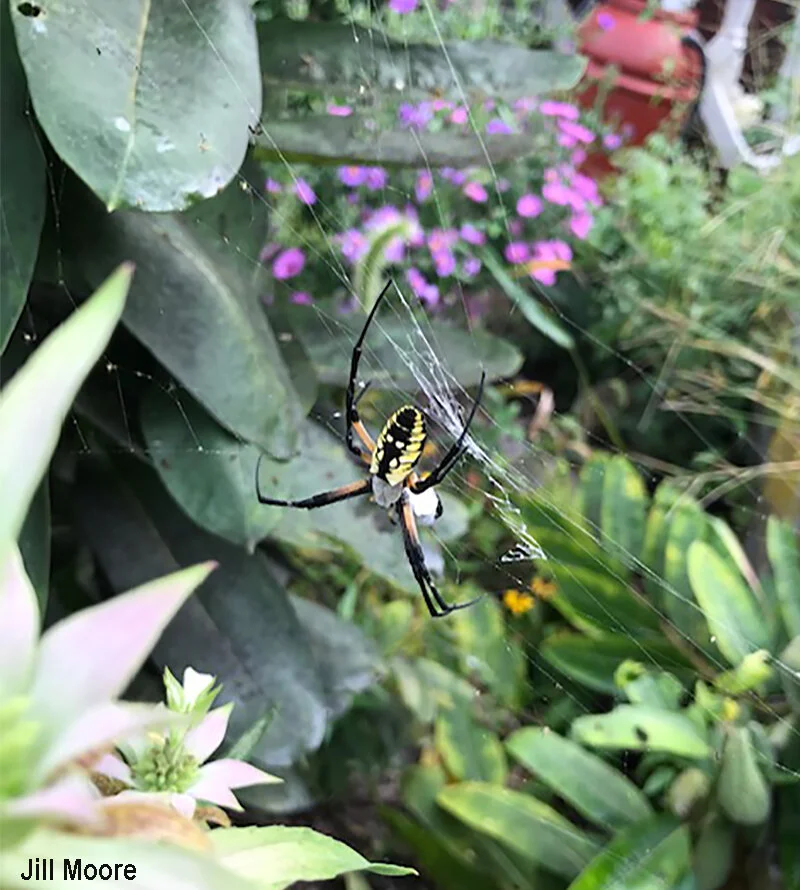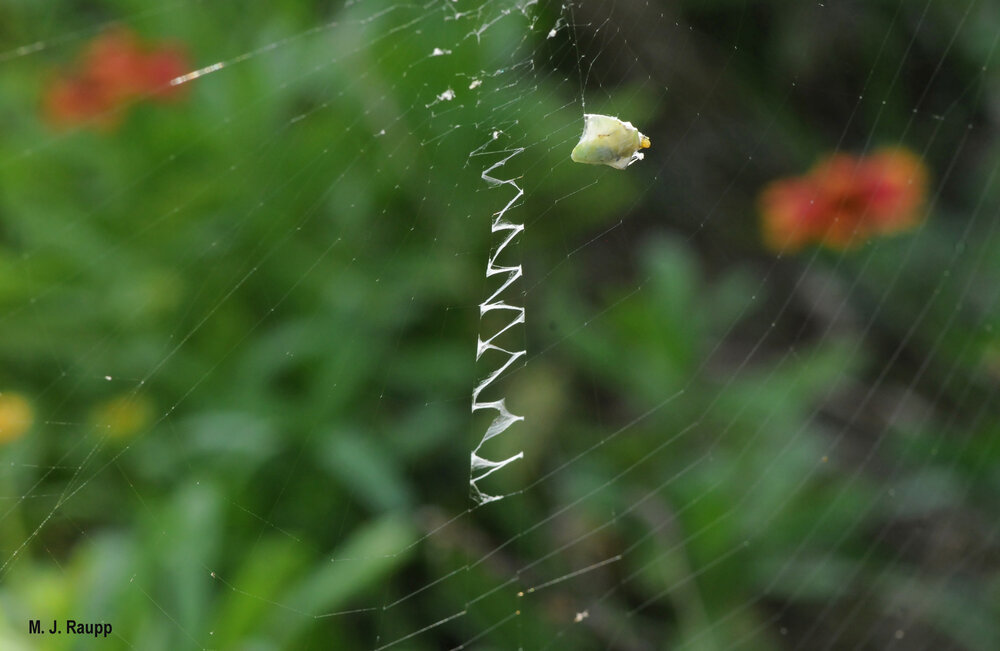Garden spiders rockin’ in the DMV: Black and yellow garden spider, Argiope aurantia

Gardens around the DMV seem to be having a bumper crop of black and yellow garden spiders this year. Image credit: Jill Moore

Black and yellow garden spiders can be quite entertaining when they spin their webs in windows. Notice the beautiful stabilimentum. Image credit: Steve Hand
In a previous episode we lamented the unusual paucity of large swallowtail butterflies in our gardens this year. But 2020 has not been a rotten season for all of our six and eight legged friends. Over the past few weeks, I have received several images and a few videos of black and yellow garden spiders who have made their homes in flower beds and gardens here in the DMV. Some of us have shared the experience of wandering along a path through a meadow and bumbling into an enormous spider web ruled by a fearsome yellow and black spider.
Argiope aurantia, the so-called black and yellow garden spider, is extraordinarily common this year in some locations. Webs of the black and yellow garden spider can be gargantuan, often spanning several feet. Fortunately for Bug of the Week and for the first time in several years, one of these gorgeous arachnids, a female by the name of Sylvia, has taken up residence amongst my zinnias where she helps to keep blow flies, stink bugs, and other less desirable arthropods at bay.
One of our past resident black and yellow garden spiders, Charlotte, demonstrates her skill at immobilizing and capturing prey. A brown marmorated stink bug stands no chance once it encounters the sticky strands of the web. Charlotte’s attack is eerily reminiscent of Frodo’s unfortunate encounter with Shelob in route to Mount Doom. After immobilizing the stink bug, she returns to feast on the remains of a former, now unrecognizable, victim. Spiders, along with many other home-grown predators, are part of the reason stink bugs are not the problem they once were here in the DMV.

A stabilimentum of heavy silk adorns the center of this web.
One of the signature features of Sylvia’s web and those of other orb weavers is the construction of a zigzagging band of dense silk called a stabilimentum near the center of her web. The function of the stabilimentum is a topic of debate among arachnologists. Some suggest that the band helps disguise the spider from its predators by providing a form of camouflage as the spider rests in the center of its web. Others believe that the silk may act as a tiny parasol shielding the spider from intense rays of the sun. One fascinating study revealed that the conspicuous bands of silk acted as a visual warning to low flying birds, reducing the likelihood of devastating web-destroying crashes much the same way an image of an owl on a large plate glass window dissuades misguided birds from crashing and breaking their necks. Of course, the spider cares not for the welfare of the bird, but repairing bird-damaged webs takes time away from important projects like capturing and eating insects.

How many spiderlings will emerge from an egg case the size of a very large marble?
One recent misty morning, more of a rule than an exception this year, provided a grand opportunity to witness another curious behavior of Sylvia the orb weaver, her skill at web-flexing. While stationed near her stabilimentum and grasping strands of silk, Sylvia flexed and extended her front legs repeatedly. Her rhythmic gyrations set the entire web rocking back and forth. Swaying the web in rhythmic motion is called web-flexing, a behavior often observed in orb weavers. Web-flexing has been reported as a way to dislodge potential predators, or to cause prey to become entangled in sticky capture-threads in the web. Flexing may serve other defensive purposes as well. Enemies of the orb weaver include predatory lizards, toads, and other spiders that rely on keen eyesight to locate and capture prey. In an interesting treatise on orb weavers, Wayne Tolbert suggested that web-flexing might be a clever way for the spider to conceal its exact location, thereby confounding hungry predators. On this rainy morning I wondered if Sylvia’s vigorous web-flexing might be a way to shed raindrops from the silken capture-threads of her orb. When you see orb weavers and other spiders in your gardens and landscapes, please avoid any urge to destroy them. We have found spiders to be one of the most important group of predators putting a beat-down on common pests of ornamental plants in residential landscapes.
On a rainy morning, Sylvia, a black and yellow garden spider, uses her forelegs to rock her web back and forth. This behavior known as web-flexing may help her snare prey, dodge predators, or, perhaps, shed raindrops that accumulate on capture-threads of her web. Another black and yellow garden spider has had a very successful season producing two marble-sized egg cases from her harvest of prey. Video credits: Michael Raupp and Ann Payne
Acknowledgements
Bug of the Week thanks Anne Payne, Jill Moore, Steve Hand and Gene Ferrick for sending images and videos and for donating black and yellow garden spiders, inspiriting this episode. Three great articles, “Predator avoidance behaviors and web defense structures in the orb weavers Argiope aurantia and Argiope trifasciata” by W. Tolbert, “Do stabilimenta in orb webs attract prey or defend spiders?” by T.A. Blackledge and J.W. Wenzel, and “Do top-down or bottom-up forces determine Stephanitis pyrioides abundance in urban landscapes?” by Paula Shrewsbury and M.J. Raupp, were consulted for this episode.
This post appeared first on Bug of the Week